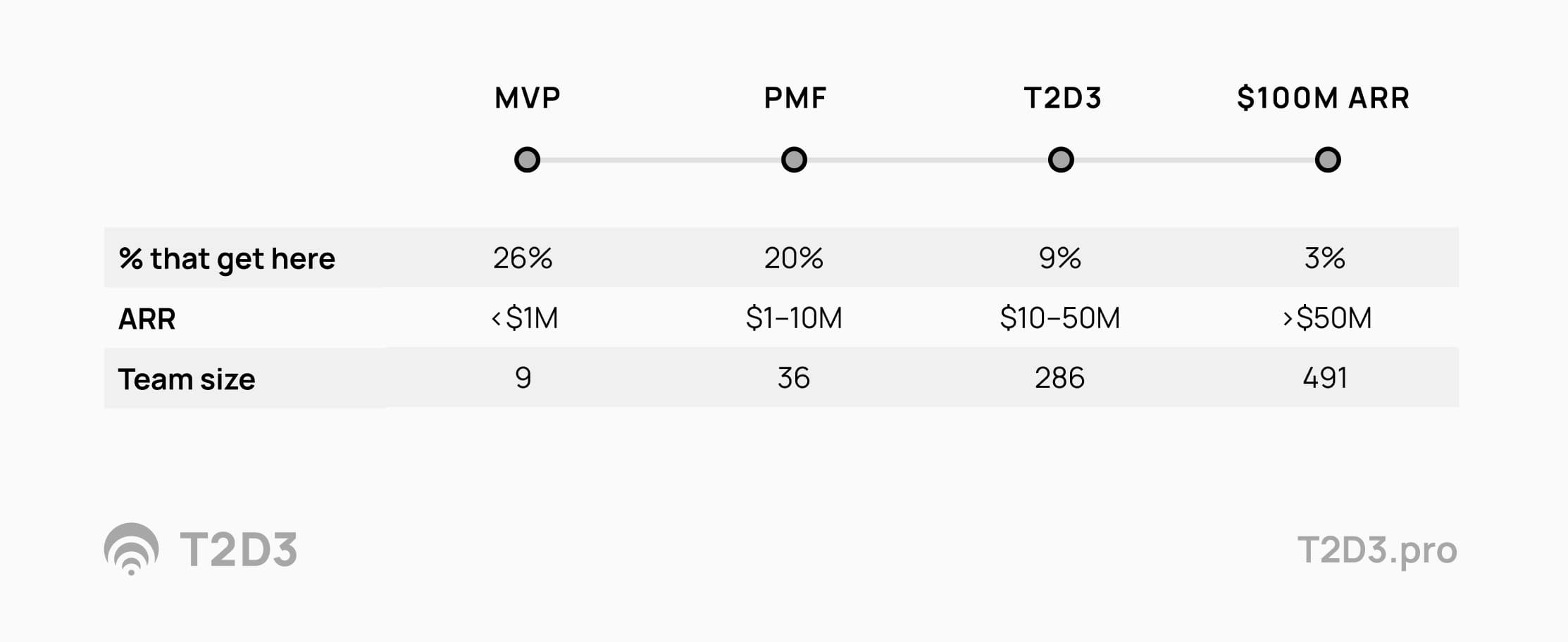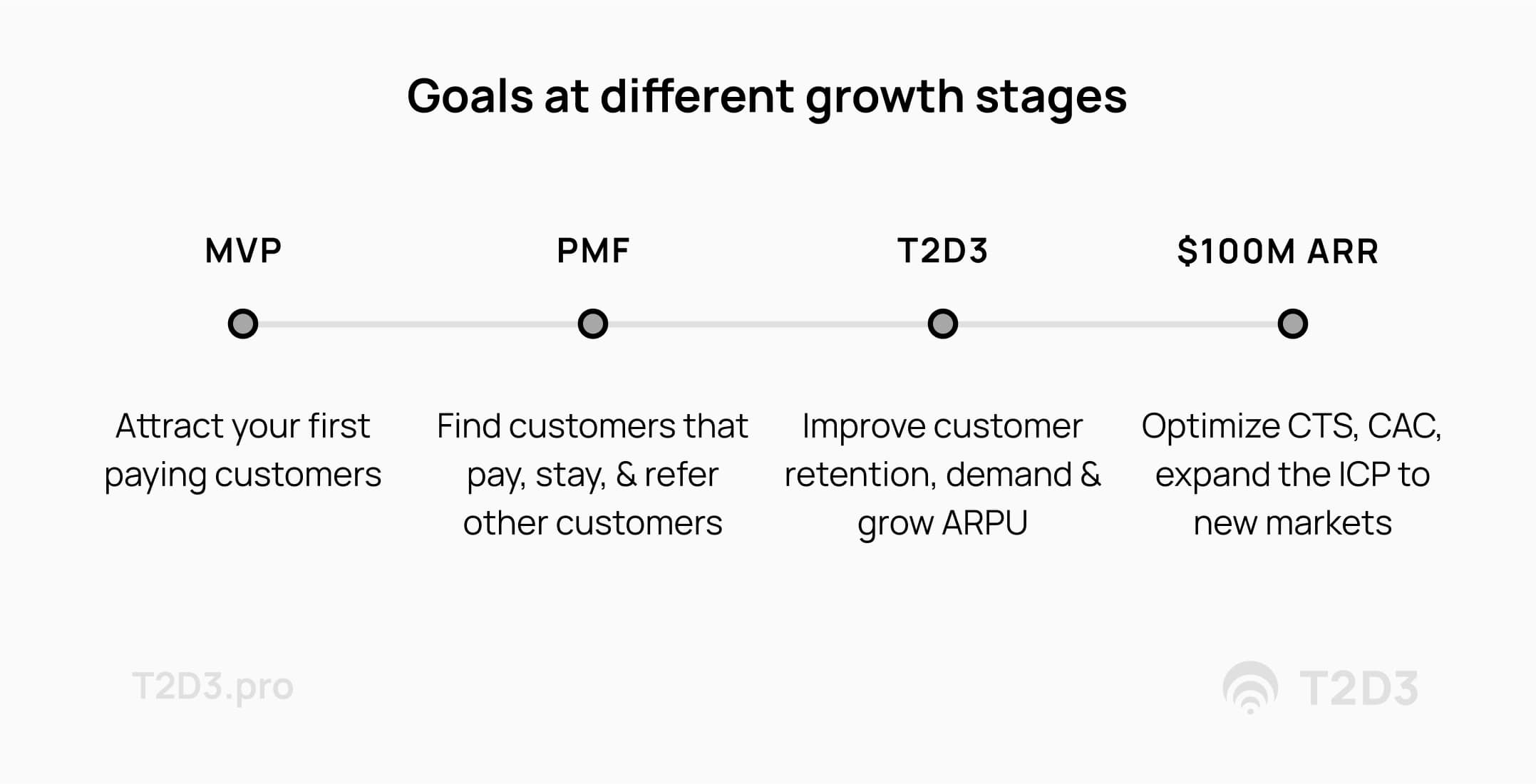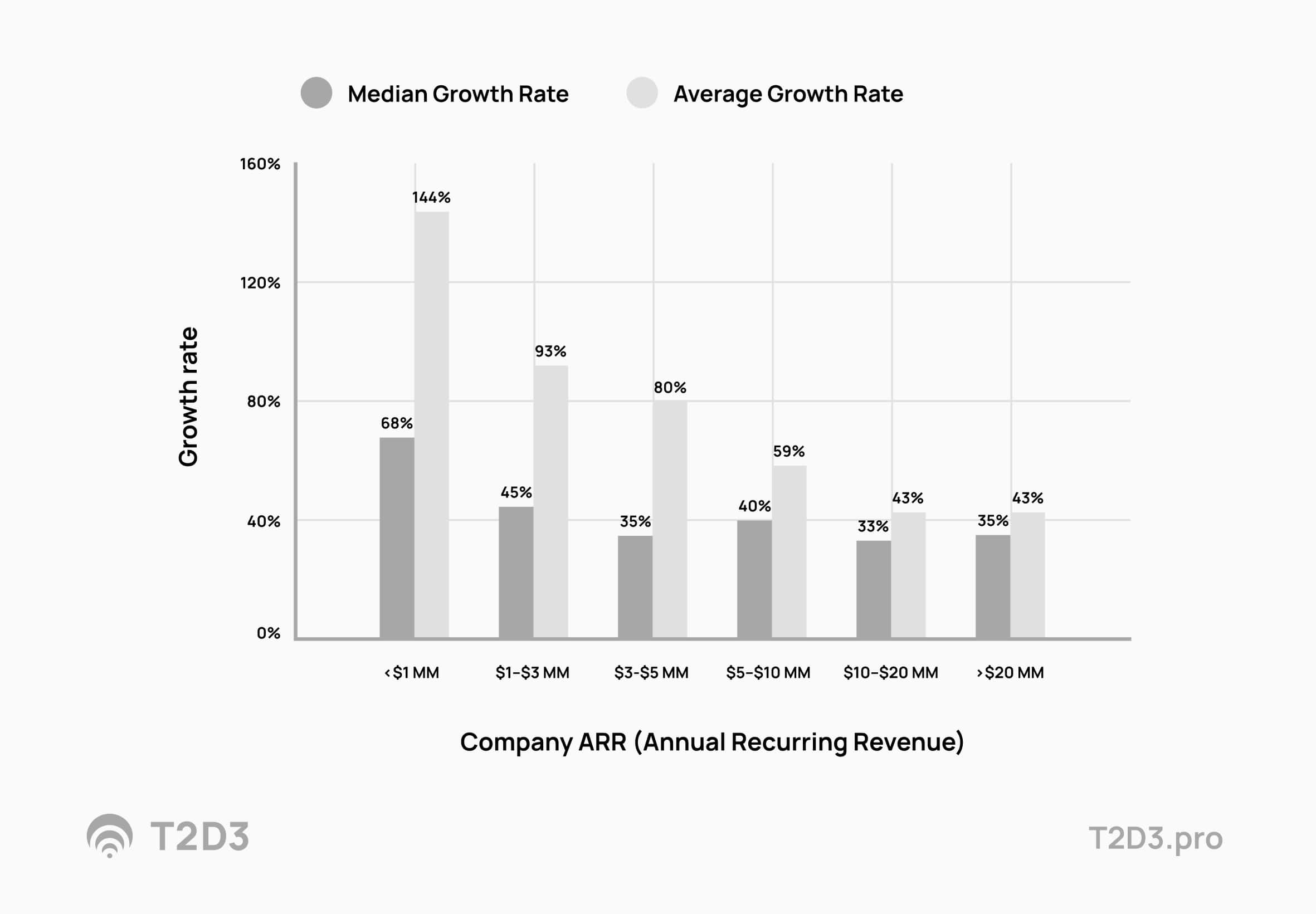Launching rockets
Rockets use momentum to propel them out of Earth’s gravity field. These days, rockets have at least two stages.
The initial stage is used to push the rocket into the lower atmosphere, sometimes with the help of boosters mounted on the side. This first stage has the most work to do, lifting the entire rocket, its payload, and all the unused fuel. While air resistance increases with speed, the atmosphere also gets thinner as the rocket climbs higher. This is strikingly similar to scaling your T2D3 marketing plan.
Getting your SaaS Startup to create a Minimum Viable Product (MVP) and then to reach Product Market Fit (PMF) is like the first stage of a rocket launch. It takes most of the energy and many things can go wrong. In addition, it’s critical to point your rocket in the right direction to achieve its desired destination.
Once the first stage of the rocket has completed its job, it shakes off the boosters and ignites the second stage.
The second stage has much less to transport, and it does not have to fight through the thick lower atmosphere. This is like getting your SaaS venture to accelerate to T2D3 growth speed, often with the boost of external growth funding from a seed round or Series A. Your attention now needs to change from pushing and making a market to guiding your company along the right path while you keep adding speed. With fast growth, it becomes easy to get off track (i.e., pursue too many markets or do too many things).
Let’s dive into how to do the right things in the right order as you pick up speed.
The four growth stages of B2B SaaS company
View clip on YouTube
Access all lectures by signing up for the Masterclass program
While a rocket launch helps explain the energy needed to achieve SaaS momentum, I find that baseball helps explain the process. Most people know the movie “Moneyball,” about Billy Beane, manager of the Oakland A’s, and his non-traditional approach that allowed his club to compete against teams with much larger budgets.
However, Billy Ball is something else again. When Billy Martin led the same Oakland A’s 15 years earlier, he realized he didn’t have the long ball at his disposal as his teams usually didn’t have many home run hitters. He started to play small ball to manufacture runs. Bunts, stolen bases, suicide squeeze plays, sacrifice flies. This allowed him to move his runners around the bases one base at a time.
Chances are a SaaS CEO will not hit a home run and get to $100M ARR right off the bat.
He or she needs to get their SaaS Solution on first base and then work its way around the subsequent bases to score. They can’t take shortcuts and go from the batter’s box directly to second base. They must go to 1st, then 2nd, then 3rd, then home. Sometimes, if they’re fortunate, they can score several runs at a time…but this is very hard to do and impossible to predict.
For Software Startups, the best recipe to scale is to go through the successive steps of getting to Minimum Viable Product, then to PMF followed by T2D3. It’s hard work, but it’s not black magic. These stages can be recognized, understood, and optimized.
The journey for B2B SaaS companies can be simplified to a baseball diamond with the following four B2B SaaS Marketing Strategies:
- Get to MVP: 1st Base
- Reach PMF: 2nd Base
- Achieve T2D3: 3rd Base
- $100M ARR (or getting to the "rule of 40"): Home Plate
-min.jpg?width=2226&height=1299&name=T2D3%20-%20the%20four%20B2B%20SaaS%20growth%20stage%20milestones%20(rounding%20the%20bases)-min.jpg)
The sequence of the major milestones in the SaaS growth journey is always the same, and shortcuts will cost you. Just like in baseball, you must round the bases to score and achieve B2B SaaS success.

I have seen companies try to skip a real PMF focus. You need customers who do not just pay but also stay. Trying to jump from MVP to T2D3 revenue scale (or worse, profit) usually does not end well. Pressure from investors is best met with a specific plan that shows how you make progress in getting to real measurable PMF. Bold numbers that project a near future with high profits that are not based on real PMF facts are just wishful thinking. This will not get the job done. Skipping MVP or PMF drives frustration for the team and shareholders because you will likely have to return to earlier stages to fix things.
Get to MVP by attracting your first paying customers. While the numbers in the table above are rough estimates, the goals at each stage are solid:
- Reach PMF and get many customers to pay & stay.
- Achieve T2D3 Scale through customer retention, customer referrals & revenue expansion (ARPU).
- Get to $100M ARR by optimizing Cost to Service and evolve the Ideal Customer Profile and Go-to-Market.

The final "$100M ARR" milestone, can also be replaced by a common metric used by investors described as "the rule of 40", basically getting to a combined 40% profitability and growth rate number.
This blog series and the ‘T2D3’ book focus on what it takes to get through these stages. After getting to first base with $1M in ARR, it is now time to scale to $10M, and then to $100M.
How do you get to product-market fit? Can your company be one of the few that make it to 3rd base? Can it achieve sustainable, scalable ARR growth with SaaS T2D3 flywheel momentum? After that, how do you take your company global, optimize your cost-to-service customers after scaling fast and diversify your Go-to-Market with for example a channel model?
Where are you on your T2D3 growth journey?
Here are some considerations to help you determine where you are on your T2D3 growth journey.
1st base: MVP
Problem & solution confirmed
- A small # of customers are paying to keep your solution
- You've developed features that customers need
- Users are actively using your product daily
- Users have helped improve your product (they “vote with their time”—usually innovators)
- Users share why your solution is important to them
- Users ask you to develop the next version
2nd base: PMF
Market beachhead established
- Paying customers are staying
- Customers are agreeing to be references
- Your annual customer (logo) churn is decreasing
- Lead conversion rates are increasing (especially ones that resemble your ICP)
- Users experience the value of your solution: Their usage (number of logins, etc.) increases, and they praise your solution without being prompted
- Conversions from trials to purchases are increasing
- “Engaged advocates” use your solution and are starting to tell others about it
3rd base: T2D3
Expanding from your beachhead
- Annual Logo churn is <15%
- Customers are consistently paying, staying, and referring others
- You have a large number of published testimonials
- You get customers from multiple demand generation sources
- 25% or more of your customers are coming from referrals
- Revenue churn is decreasing
- User numbers per account are growing
- User churn after onboarding decreases
- ARPU is growing through account management and upsells & cross-sells
Home: $100M ARR
Driving profitable, sustainable growth
- You successfully enter new customer segments (going up/down market, going global)
- Partners extend your solution, sell- or service it, and help reach new markets
- You manage discount levels and mature price evolution (value-based, inflation+)
- CAGR and gross margin add up to 40%+ (Rule of 40)
- Beyond 1,000 raving fans, user groups are forming supporting each other
- Independent customer discussions, user communities, and events are sprouting up
- Books get published by 3rd parties to cover your solution with training content
- Analyst firms are naming you as a category leader
Don’t run scared
While you cannot skip any of these milestones, you should still go as fast as possible. Taking risks to steal second base and get to PMF is part of the reality of running a fast-scaling startup. You can do this effectively through constant experiments, adjusting your course based on your learning, and setting short-term but ambitious goals, like Objectives and Key Results (OKRs).
A 2020 annual research study found that a $2 million ARR SaaS company needs to be growing at more than 90% year-over-year to be in the top 25% of its peers. A $10 million SaaS company needs to be growing by more than 55% to be in the top quartile, and companies up to $10 million in ARR need to be growing by at least 20% annually to avoid being in the bottom quartile. Consider this your benchmark when signing up to get a B2B SaaS company to scale.
